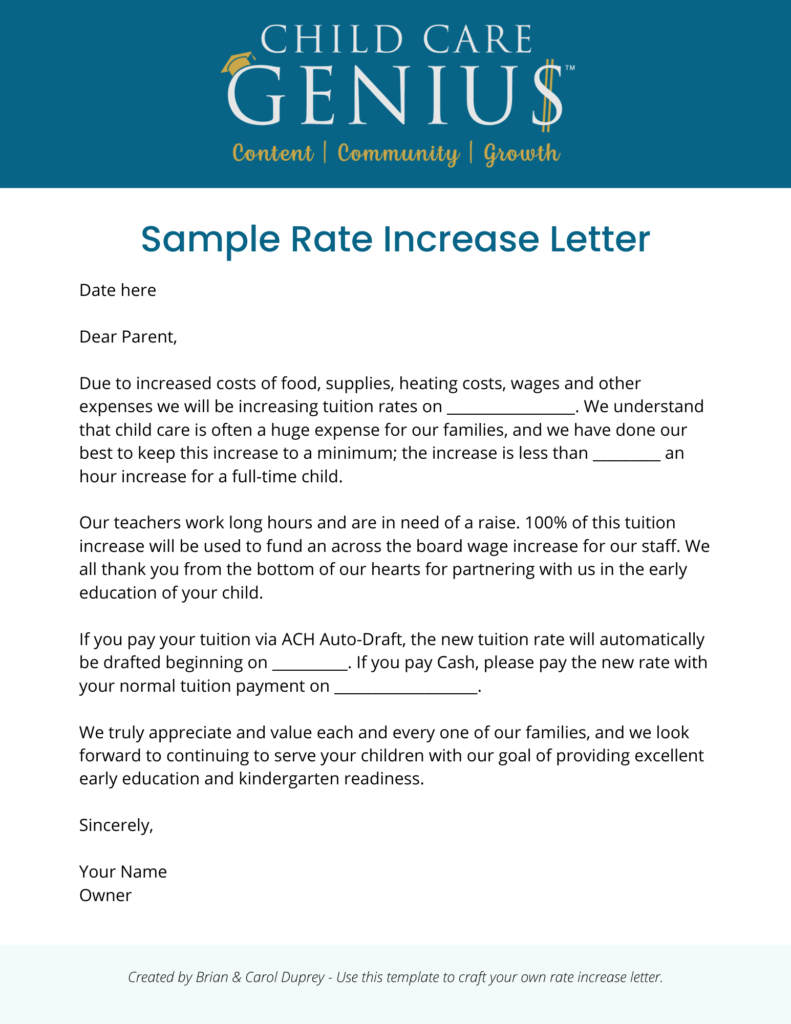In our many years of coaching child care business owners and conversing with colleagues in the business, we have learned that many child care owners are afraid to raise rates in childcare. We often ask what the reason for this is, and have noticed there is a common theme.
Guilt: The center owner knows these families personally and knows that an increase could put a financial burden on some of them.
Fear: The owner is afraid many of the families will leave for a cheaper alternative.
Complacency: The owner feels they are making enough money in the business and does not want to upset the status quo
While all of these may seem like good reasons to keep your rates the same, they will hurt your business long term.
Why Not Raising Your Rates Annually Will Hurt Your Business:
Raising your tuition annually will allow you to increase wages for your staff members. Since COVID-19 came on the scene in 2020, it has been more difficult than ever to attract and retain staff in many service-based industries, including child care. As a result, wages are rising fast in many sectors and we have to be able to keep up with the competition for our workers from inside and outside our industry. Offering the most attractive wage possible will be more important than ever to finding staff for your school.
Tuition increases allow you to keep up with the cost of living. Each year you have to pay more for most of the products and services you consume at your center. Electricity, fuel, food, supplies, and many others all have cost increases annually that you need to keep up with.
Not raising tuition can put you at a competitive disadvantage. You have to make sure that your center has the latest equipment and is paying competitive wages, which cost money.
It could impact the state reimbursement rates in your area. If you are charging less than market rate for child care, you are really hurting yourself and all of the centers in your area as well. The state will use market rate data to determine child care reimbursement rates, and when you keep your rates low it keeps reimbursement rates low which hurts you with future subsidized children. Always be within 5% of the competitors in your area, just do everything better than them. If you continue to follow the Child Care Genius Podcast and our trainings, you will be a step ahead of everyone else and your center will be full when they are struggling to get children.
Now that we have established that we need to raise our rates annually, how do you know how much to raise them by?
There are several factors that we take into consideration when raising rates. We NEVER raise rates a certain percentage across the board for all age groups.
Here are a few of the things we consider when deciding how much to raise each age group:
How much money do you need to raise to pay for increased wages, upgraded equipment, utility, and vendor cost increases in the new year? Take this amount and divide it among the amount of families you have to give you a ballpark amount you need to raise each family by. This is your starting point. From here you can start looking at other factors.
How much are my competitors raising them by? Mystery calling the competition in December is a must and asking them what the rate will be in the new year.
Supply & Demand. Do you have any age groups that are full with a waitlist? If you have an age group that is full with a waitlist of 5 or more, you can raise rates by almost double the amount of rooms that are not full.
Example: If we want to do a 3 percent raise in our preschool classroom (3% is a safe amount each year you can raise without really having to justify it to your families.) If you have an infant room that is full with 10 on a waitlist, you should raise that age group tuition probably by close to 10%. This is simple economics, supply and demand. You may have a family leave for a cheaper option, but there are 10 families right behind and most will pay the higher price.
You will need to notify parents at least 2-3 weeks prior to a rate change that rates are going up. I would put an explanation in the letter that you are using the increase to pay for increased wages and upgrading equipment. This will get the least amount of pushback from parents. You might still have a couple of upset parents, but most will just pay the extra amount. You may have a family or two leave over it, but you cannot worry about that. Be confident and do not back down. You are a business owner and do not be apologetic for having to be adequately compensated for taking care of their most prized possession.
We established that you need to raise your rates at least annually, however, in some markets you need to raise them twice annually to keep up with inflation. You are probably saying, “I can’t do that to my parents they will all leave me”. We will show you the secret to raising rates that they won’t even notice.
We have a policy of raising our rates on January 1 and July 1 of each year. The January 1 increase is across the board and it depends on market forces. It could as little as $5 a week and as much as 10% increase depending on inflation and what other centers in my area are doing (as described above). This increase is for all existing customers.
Our July 1 increase is a hidden rate increase. We survey market data and if another increase is warranted we raise rates across the board for new families only. Doing this also raises the rates for existing families, but only when they have a birthday and get a rate adjustment.
For example: Let’s say you have a 2 ½ year old that pays $250 a week for care (toddler rate) and normally the rate would decrease when the child turns 3 to $230 a week. You do a $10 a week rate increase for new families only. When this toddler turns 3, they will now pay $240 a week due to the $10 a week increase on July 1. The parent never knew that rates increased.
Two things:
1
In your handbook put a statement that says tuition rates are subject to change at any time with or without notice.
2
Post the new tuition chart in your lobby on January 1 and July 1 so that it is available for public display.
Not raising your tuition at least annually hurts your business and hurts your teachers. They deserve a pay raise, this increase is for them. When we raise our tuition in January we tell our families this tuition increase is going to the teachers who work so hard caring for the children, and we never get any push back because of how we frame it.
If you need some help communicating a rate increase to your families, use our rate increase letter template as a starting place. Adjust it to fit your needs:
Download Our Sample Rate Increase Letter Now:


